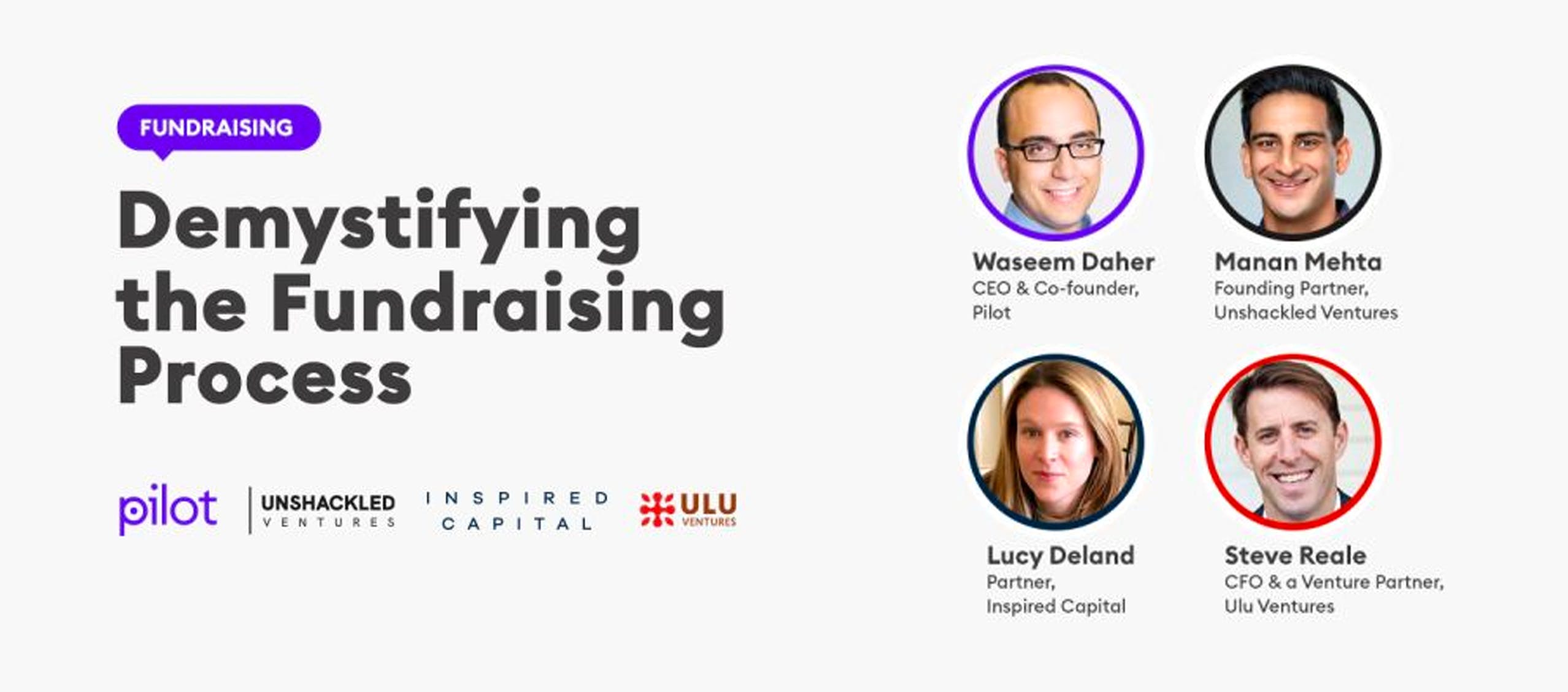Watch: Demystifying the Fundraising Process
A confirmation email has been sent to your email.

We recently pulled together an all-star VC panel to share their insights on the process of fundraising, particularly for pre-seed and seed-stage companies. Watch as Lucy Deland of Inspired Capital, Steve Reale of Ulu Ventures, and Manan Mehta of Unshackled Ventures join Waseem Daher to answer questions about what they look for, and what founders should know about raising capital.
Excerpts are posted below, and you can watch the whole 60-min session here.
The Common Mistakes They See Founders Make
Lucy Deland
This may seem like a very obvious piece of advice, but practice, practice, practice. You talk about your company all the time, but your specific pitch and your specific narrative? You can’t do it too often. There’s no such thing as too many times before you give it for the first time in a formal meeting. And so, we really sing that gospel here at Inspired, and it was something that, when I saw my own team misstep, it was that we hadn’t practiced enough.
Steve Reale
Yeah. And Lucy, just to add on there. I think the practicing, the dynamic between the founders is really important too. Because as an early-stage investor, we’re betting on a team and you get to see the dynamic between the founders. And if one dominates the conversation or overshadows the other, you don’t understand how they work together. And we’re trying to glean cultural aspects of the company also at that point in time. So, I think it’s a good point you bring up.
Manan Mehta
Yeah. I think what Lucy and Steve both outlined is critically important, right? Because it’s really awkward for whether you’re on Zoom or in person and the founder dynamic is a tug of war. It’s extremely awkward, and we all feel it. I think the other part that I tend to encourage, specifically founders that are at the pre- seed stage in their journey is, I try to challenge them to think of something or share something that I couldn’t find online myself.
There’s something around customer discovery and customer insights that a lot of founders don’t take seriously enough. And I try to encourage founders, especially at that stage when you’re still kind of a dissertation paper, right, at the pre-seed stage? You don’t really have a product. You don’t have any revenue. Come up with a framework on maybe what your customer, your end user is no longer willing to tolerate…if you think about that from a problem solution perspective, in your arc of building a company with venture capital, that customer insight of what they no longer want to deal with at the pre-seed stage is critically important on what you’re going to build.
And so, practicing that with your co-founders, and understanding who can control that narrative effectively goes a really long way in the sense of making us believe in you, that you have a belief that you can solve this problem.
How How to Get In Front of Investors
Waseem Daher
This is a question that we frequently get asked, and I think it’s a hard one, which is, how can folks actually get in front of the investors they’re trying to reach? And maybe I’ll ask the question very explicitly. Do you folks take cold pitches? Or if someone wants to meet with one of your firms, what actually works and what doesn’t in terms of getting an initial meeting or getting a little bit more information or getting something on the calendar?
Steve Reale
I’m happy to start, because we’ve actually been trying to think through this a lot lately, especially as Ulu’s focus is really, to back diverse teams. And a lot of times, diversity comes from directions where we didn’t expect it to come from. So, we’ve actually really streamlined what I would call our “cold call”, like contact us process, even at Ulu. And anybody can submit a business plan through that contact us process.
And it comes into our pipeline and gets run through a series of screens with mostly my other venture partners. We do typically a quicker screen on it before we bring things to the partnership. But we’re trying to democratize some of that process, but it is hard. I mean, I think that it always helps to, like, if you’re going to approach a firm, you try to approach it from a couple different directions versus just going through the inbox.
And a lot of us are increasingly visible out there anyway. So, trying to touch us in a couple different ways is often helpful. But we structurally really tried to change the outlet that is open to the entrepreneurial community.
Lucy Deland
We actively manage our hello@inspiredcapital. And as you said, all of our emails, lucy@inspiredcapital. I get lots of spam too because of that simplicity. It’s open and I’ve definitely taken cold pitches. I’ve built some of my relationships with favorite entrepreneurs through that. I would say, if I were trying to raise a pre-seed or a seed round right now, one of, I think, an underutilized space is going and tapping founders.
So, I know when I was an operator, I had newly minted founders reaching out to me. That’s a great source for close and personal introductions. And often, they would be happy to do a 15 to 30-minute Zoom with you to hear your idea. If they like it, we’ll make a loose but nice introduction to the investors and their network.
Manan Mehta
Yeah. For us, seven years ago when we start Unshackled, we made it very clear that we would not prioritize warm over cold intros to Unshackled. So, seven years ago, we put a form on our website in every deal, whether it’s referred to by Lucy, Steve, Waseem, or Elon Musk. Go to exact same form.
Waseem Daher
Awesome.
Manan Mehta
And we have built our entire process through that to be blind to source-of-intro until we want to see it. And every week, three investment teams will review the entire pipeline. And then, we’ll set up for companies we want to meet, 20-minute pitch meeting for the partnership. Tuesdays and Wednesdays, we have multiple tracks. Our job is to see people, not their decks, because we’re investing in immigrants. And not all immigrants have warm intros.
And we don’t think that should be the termination of VC funding. And so, it’s been a big part of us. I mean, last year, we saw 1800 deals that came through our form. And that’s how we track our deal volume. We obviously can’t invest in all of them. We only invested in 15 companies last year. But we think there’s something really elegant about being the first investor in many companies to make it as equal as possible to be that on-ramp to everybody else.
On Investor Feedback
Waseem Daher
I think the natural instinct of the entrepreneur frequently, if they’re told “no, that isn’t a fit,” is frequently to react very defensively in a way that I think is unfortunately, not very productive. In other words, if I’m the investor and I send you that email, “Hey, listen. It’s not a fit because of XYZ.” I’m probably not looking for a 20 paragraph rebuttal about “Oh, no, I don’t agree with point A, I don’t agree with point B.”
And instead, I think what I generally advise people is, well, okay, let’s take that data, and let’s incorporate it into the next rev of the pitch. So, let’s incorporate it in the next targeting we take. And maybe this goes back to your point initially, Lucy, about practice, practice, practice. What are the things I’m hearing often? How can I work that into my narrative? How can I work that into my story?
I’m curious, too. Does that resonate with our panel here?
Lucy Deland
I think that’s very good advice. I think that there’s very rarely a productive next step that comes out of a defensive response. I think, if you truly have a question or you want to dig deeper, I really respect someone writing back and saying, “Can you help me understand exactly what you mean by point two? Do you mean X? Or do you mean Y? If it’s the market size or if it’s the go to market strategy that I’ve mentioned?”
That I think is you trying to take in information and learn. And I’m always quick to say, “I don’t have a crystal ball either. We’re all here trying to see around corners.” So, everything I say, I mean I watch these all the time, but take with a grain of salt. But one thing a founder said to me recently, which I think is great advice, and I hadn’t really thought about it as much as I should have before was, he was helping a few other founders and listening to their pitches to give them feedback.
And he found that it was the best thing he could have done to prepare for his upcoming fundraise. Because he sat down and tried to give feedback as an investor. He found things about the way they structured the narrative, how they presented a specific point. He was like, “I do that, and I don’t think it’s effective now that I’m listening to it.” So, I think finding your founder community and offering that to each other, it’s helpful to give the feedback.
But it’s also really helpful to put yourself on the other side of the table, and to think through how you would react to a pitch.
Manan Mehta
I mean, we’ve gotten those emails. We get them all the time. And I respect the effort, right? I think there’s something that suggests there’s a lot of passion for the problem that you’re solving, and there’s a lot of conviction behind it. And I don’t want to ever be dismissive of that, at the end of the day, if you wrote that 20 paragraph email, that probably took you a good few hours. So, I want to respect the fact that there was effort and time in there.
But…I have a nine-month-old daughter. And if I want to convince her of anything, it’s more on me than on her, right? So, how am I communicating? How am I contextualizing? How am I presenting? And obviously, I use her because she can’t really process too much. She’s still very young. But at the end of the day, I have to move her, right? It’s on me, not on her to receive in a certain way..
And so, I need to understand if she’s well fed. Well, I mean, those parameters. Is she tired? And then, act. Same thing with VCs, have they just invested in something similar? Did one of the companies they invested in go sour? Understand the context if you can. And then, present your story in a way that first time that would resonate. So, a little more self-reflection goes a long way in terms of like, maybe it’s not them, maybe it’s how I communicate to them this one time.
The next time I can change it up, because I do think what I’m doing is right. And we would welcome that founder to come back and pitch us. It could be a week later. It could be a month later. We have no problem with boomerang deals. Just as long as it’s that thoughtfulness that Lucy was outlining, I think goes a long way.
Steve Reale
Yeah. And I think that Lucy made a comment about being careful to recognize that every investor is a data point. And it’s actually a really good thing to take feedback and say, “Okay, Ulu said no. This is why they said no.” Let me reflect on this. And when I talk to the next seed stage group, is there something that I should refine about what Ulu told me, because that’s kind of interesting?
And then, if you get another data point that is similar, then you have two data points, and then you have three, and then you have four. And so, being open to feedback. I mean, provided an investor gives you feedback versus just “we’re passing, good luck,” which I don’t think a lot of us are doing anymore. I mean, I think everybody acknowledges this is a collaborative ecosystem. We all want to build brand and presence with entrepreneurs.
But take feedback as a learning also. And then, come back to us constructively. To Manan’s point, we look at deals that come back three, six months, twelve months later, and they’ve got more data points, or they’ve pivoted. And we’re always open to take that call.


